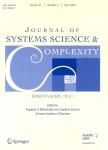Comprehensive G?bner Basis Theory for a Parametric Polynomial Ideal and the Associated Completion Algorithm
Comprehensive G?bner Basis Theory for a Parametric Polynomial Ideal and the Associated Completion Algorithm作者机构:Department of Computer Science University of New Mexico Albuquerque NM USA.
出 版 物:《Journal of Systems Science & Complexity》 (系统科学与复杂性学报(英文版))
年 卷 期:2017年第30卷第1期
页 面:196-233页
核心收录:
学科分类:07[理学] 0701[理学-数学] 070101[理学-基础数学]
基 金:supported by the National Science Foundation under Grant No.DMS-1217054
主 题:Comprehensive GrSbner basis minimal comprehensive GrSbner basis parametric polyno-mial system parametric S-polynomial redundancy.
摘 要:Groebner basis theory for parametric polynomial ideals is explored with the main objec- tive of nfinicking the Groebner basis theory for ideals. Given a parametric polynomial ideal, its basis is a comprehensive GrSbner basis if and only if for every specialization of its parameters in a given field, the specialization of the basis is a GrSbnerbasis of the associated specialized polynomial ideal. For various specializations of parameters, structure of specialized ideals becomes qualitatively different even though there are significant relationships as well because of finiteness properties. Key concepts foundational to GrSbner basis theory are reexamined and/or further developed for the parametric case: (i) Definition of a comprehensive Groebner basis, (ii) test for a comprehensive GrSbner basis, (iii) parameterized rewriting, (iv) S-polynomials among parametric polynomials, (v) completion algorithm for directly computing a comprehensive Groebner basis from a given basis of a parametric ideal. Elegant properties of Groebner bases in the classical ideal theory, such as for a fixed admissible term ordering, a unique GrSbner basis can be associated with every polynomial ideal as well as that such a basis can be computed from any Groebner basis of an ideal, turn out to be a major challenge to generalize for parametric ideals; issues related to these investigations are explored. A prototype implementation of the algorithm has been successfully tried on many examples from the literature.



